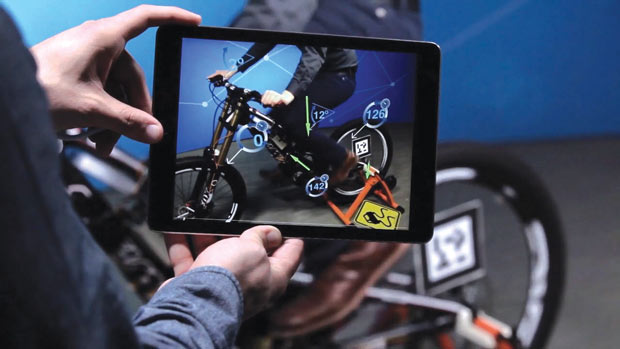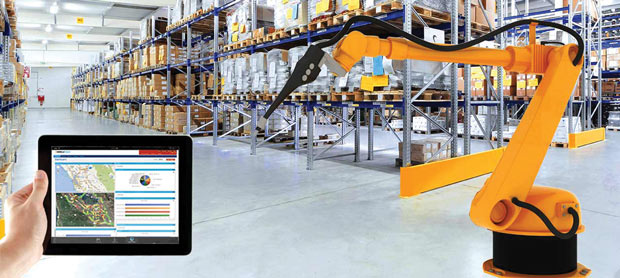
PTC’s vision of a digital twin involves a one-to-one representation of an individual product. Image courtesy of PTC.
Latest News
December 1, 2015
 PTC’s vision of a digital twin involves a one-to-one representation of an individual product. Image courtesy of PTC.
PTC’s vision of a digital twin involves a one-to-one representation of an individual product. Image courtesy of PTC.
Given the ever-increasing complexity of today’s multi-domain products, the practice of digital prototyping is evolving with the digital twin—a concept that carries the traditional 3D representation of a product into the new reality of a converged physical and virtual world.
While definitions vary, the digital twin is increasingly being used as a way to describe a means of connecting information about the physical product and its behavior in the real world with the 3D digital representation so commonly employed by engineering and other areas of the business. The requirement for viewing, interacting and getting information about the product in a blended virtual and digital world is in part being driven by the Internet of Things (IoT) and the rise of connected products.
“Product complexity is driving a need to bring multiple people together more efficiently to collaborate and that is accelerating the need to create convergence between the real and virtual worlds,” says Eliane Fourgeau, CATIA Systems’ senior director of Sales at Dassault Systèmes. “It’s critical because you need to make sure the product you’re putting on the market is the right product and is delivering the right services.”
That’s one company’s view of why a digital twin is important. Dassault’s primary competitors in the CAD space—PTC, Siemens PLM Software and Autodesk—are also bullish on the concept and its potential benefits, but they all have different ideas of what constitutes a digital twin and alternative plans for where it fits best in the scheme of a product’s lifecycle. All are in agreement, however, that a digital twin can deliver efficiencies to the design and production processes, improve product quality and innovation, and foster better serviceability of products, ultimately benefitting customers.
For Dassault, the concept of a digital twin (or a virtual twin, as the company prefers to call it) is an extension of its systems engineering strategy, enabling design teams to conceive and architect a cross-disciplinary product that combines mechanical, electrical, electronic, hydraulic and control capabilities, among other domain properties. As part of its 3DEXPERIENCE strategy, which is an environment for engineering a system or a product in the context of its whole experience, the concept of virtual twin will enable design teams to experience a product before it exists. In this way, engineering teams see not just static mockups of a product or system (the traditional 3D digital mockup driven by CAD), but rather provide insights into physical behaviors like stress and vibration as well as behaviors associated with the software and control systems, Fourgeau explains. “In a sense, think of it as creating an avatar that behaves as something would in real life,” she says.
Essential to Dassault’s strategy are model-based design capabilities for modeling, simulating and validating complex engineering systems. As part of its systems engineering portfolio, the 3DEXPERIENCE platform uses the Modelica language and Functional Mockup Interface (FMI) standard so multi-physical systems can be modeled and easily composed, promoting reuse and cross-domain exchange while supporting an open ecosystem, Fourgeau says.
Creating and leveraging this virtual twin at the beginning of the process—not later on in the detailed design stage—is one thing Dassault says sets its strategy apart from competitors. “Take the example of an energy efficient building—you can wait until you build it, put sensors in, and have an IoT system tell you if it’s efficient or not, or you can create a virtual representation of that building and experiment, putting double pane glass here or changing the exposure of the building with regards to sun,” Fourgeau says. “In that way, you continue to play what-if scenarios until you are satisfied and then start the detailed development of the building.”
Siemens PLM Software sees the concept of the digital twin as the intersection of four different worlds coming together: Product design, manufacturing planning, factory design and the real world—with an emphasis on production. “The digital twin does something very unique by merging the virtual and real worlds of production,” says Aaron Frankel, senior director of product marketing for Siemens PLM Software. “Now you can take the as-designed model and all the information you are collecting from the production environment about performance and quality, overlay them on a digital model, and compare the as-designed and as-built worlds to see if there is a difference,” he says.
This view advances the concept of digital prototyping by taking into account all that can happen with production processes, full proofing a product design by eliminating the possibility of failure, according to Zvi Feuer, Siemens PLM’s vice president of Manufacturing Engineering Software. “The digital twin is the avatar of the product process and the factory all together,” he says. “If you can take failure off the table, companies will be willing to be bolder and take bigger risks.”
The underpinning of Siemens’ digital twin concept is the Teamcenter data management and collaboration platform along with various other components, some from its simulation and factory optimization tools and others from its Manufacturing Execution System (MES) and factory automation suite.
 Using the Tecnomatix process planning and simulation tools, Comau is able to create a digital twin to validate production lines. Image courtesy of Siemens.
Using the Tecnomatix process planning and simulation tools, Comau is able to create a digital twin to validate production lines. Image courtesy of Siemens.
Autodesk’s digital twin vision spans both the factory and product, making use of augmented reality technologies borrowed from its media and entertainment software line as well as capabilities from SeeControl, an IoT cloud services platform provider it acquired in August. “SeeControl is the underpinning of our digital twin,” says Diego Tamburini, manufacturing industry strategist at Autodesk. “It allows you to quickly connect to a sensored device and get data, which can be overlaid on a 3D model.”
Viewing that data overlaid onto a real physical product using augmented reality technology is where the rubber meets the road, Tamburini says. “There’s an obvious advantage to looking at data at the source—for example, looking at temperature or stress values in the exact location of the product,” he says. “That’s very intuitive and you don’t have to do any mapping in your head. If you’re looking at a 3D model, it takes too much black magic to get the sensor data displayed there.”
Augmented reality will be part PTC’s digital twin vision in light of its acquisition of the Vuforia technology (see “PTC Gets Real with Augmented Reality”). For now, however, the company is talking about the concept in the context of product development, but more vociferously in the area of field service and operations, according to Mike Campbell, PTC’s executive vice president, Digital Twin.
Unlike the traditional CAD model used in virtual prototyping, which is a general representation of a multitude of products, Campbell says PTC sees the digital twin as a one-to-one representation of a unique physical product already out there in the real world. “A digital twin associated with a specific product is the key idea here,” he says. “It’s this one-to-one mapping that makes it different than CAD and different from what some of our competitors are doing.”
A 3D CAD model is highly valued during the design process, but loses utility once the product leaves the manufacturing floor. In contrast, a digital twin of a smart, connected product can provide insight into how the product is behaving in the field, helping to steer product design and provide intelligence for successful service calls, Campbell says. “People design products all the time against idealized requirements—they over- or under-engineer things or products and miss the mark entirely because they didn’t understand real-world use cases,” he says. “The connectivity and digital twin provide an opportunity to understand how a product is used and leverage that insight to make the product better.”
PTC is planning a January launch of its official digital twin strategy. While Campbell declined to discuss the specifics, he said that the company is assembling a portfolio of technologies, which will include augmented reality capabilities, tools for managing the one-to-one relationship, mechanisms to collect relevant data from sensors, and a way to integrate information from other enterprise systems.
 Using Autodesk’s SeeControl technology, real-time sensor data from a robotic arm is collected, analyzed and displayed in an easy-to-digest format. Image courtesy of Autodesk.
Using Autodesk’s SeeControl technology, real-time sensor data from a robotic arm is collected, analyzed and displayed in an easy-to-digest format. Image courtesy of Autodesk.
Sysmex, a manufacturer of clinical diagnostic equipment, sees potential for the digital twin for both field service and product design applications. On the service front, field technicians might receive a digital picture flashing warnings to flag conditions that exist with a particular medical instrument rather than trying to discern something from data in a table view.
For Sysmex product designers, the digital twin will provide essential feedback on non-tangible information that can help drive future development. “By having a digital twin, field service technicians can provide detailed information about what exactly they adjusted, cleaned or lubricated rather than just providing general guidance,” says Steve Postma, enterprise architect at Sysmex. “Now engineering and development teams have a clear serviceability picture of what’s happening with the product and can leverage that in future designs.”
More Info:
Subscribe to our FREE magazine, FREE email newsletters or both!
Latest News
About the Author
Beth Stackpole is a contributing editor to Digital Engineering. Send e-mail about this article to [email protected].
Follow DE





